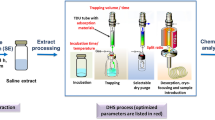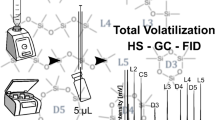Abstract
Volatile extractables such as monomers, additives, processing aids, material impurities, byproducts, and residual solvents in medical devices, released from materials during use, are a potential safety concern. Identification and quantification of volatiles released from medical devices is challenging due to the absence of qualified standard methods for the analysis. In this study, a solventless thermal extraction gas chromatography/mass spectrometry (TE-HS-GC–MS) analysis method was developed to identify and quantify volatile extractables from medical device materials. Instrument parameters and sample extraction conditions (equilibration time and temperature) were optimized with an acrylonitrile butadiene styrene (ABS), a BUNA rubber-positive control, and a high-density polyethylene (HDPE)-negative control and tested with five representative medical devices or device parts. External calibration curves generated with commonly found volatiles produced a limit of quantification (LOQ) as low as 4 ng with a linear dynamic range from 4 to 128 ng (acrylonitrile). Thermally extracted volatiles from medical device materials were compared with those from saline extraction (SE) to evaluate the suitability of the solventless TE-HS-GC–MS analysis method relative to commonly-used solvent extraction practices. Results showed that the optimized solventless TE-HS-GC–MS method, compared to the SE method, provided a 40–116% higher number of identifications. Increasing equilibration time with TE increased the number of identifications and peak area of the compounds. Several toxicologically relevant volatiles were identified in the device extracts. Overall, the optimized solventless TE-HS-GC–MS method is more effective than the SE method in identifying volatiles in medical devices/materials, while reducing the sample preparation burden and the extraction time significantly.




Similar content being viewed by others
References
M. Nouman et al., Exudation of additives to the surface of medical devices: impact on biocompatibility in the case of polyurethane used in implantable catheters: exudation of additives to the surface of medical devices. J. Biomed. Mater. Res. Part A 104(12), 2954–2967 (2016)
O. Aerts et al., Surgical mask dermatitis caused by formaldehyde (releasers) during the COVID-19 pandemic. Contact Dermatitis 83(2), 172–173 (2020)
H.C. Reich, E.M. Warshaw, Allergic contact dermatitis from formaldehyde textile resins. Dermatitis 21(2), 65–76 (2010)
G. Singh et al., Analytical challenges and recent advances in the identification and quantitation of extractables and leachables in pharmaceutical and medical products. Trends Anal. Chem. 141, 116286 (2021)
EPA, Technical Overview of Volatile Organic Compounds. Available from: https://www.epa.gov/indoor-air-quality-iaq/technical-overview-volatile-organic-compounds
R. Ito et al., Determination of tris(2-ethylhexyl)trimellitate released from PVC tube by LC–MS/MS. Int. J. Pharm. 360(1), 91–95 (2008)
S. Genay et al., Experimental study on infusion devices containing polyvinyl chloride: to what extent are they di(2-ethylhexyl)phthalate-free? Int. J. Pharm. 412(1), 47–51 (2011)
J.D. Rindelaub et al., Identifying extractable profiles from 3D printed medical devices. PLoS ONE 14(5), e0217137–e0217137 (2019)
P. Gimeno et al., Identification and quantification of bisphenol A and bisphenol B in polyvinylchloride and polycarbonate medical devices by gas chromatography with mass spectrometry. J. Sep. Sci. 38(21), 3727–3734 (2015)
J. Ulriksdotter et al., Allergic contact dermatitis caused by dipropylene glycol diacrylate in the Omnipod® insulin pump. Br. J. Dermatol. 186(2), 334–340 (2022)
S.-S. Choi, Y.-K. Kim, Analysis of trace residual 1,3-butadiene in poly(acrylonitrile- co-butadiene- co-styrene). J. Ind. Eng. Chem. 17(3), 394–396 (2011)
Y. Wang et al., Thermal desorption extraction proton transfer reaction mass spectrometer (TDE-PTR-MS) for rapid determination of residual solvent and sterilant in disposable medical devices. J. Pharm. Biomed. Anal. 55(5), 1213–1217 (2011)
K. Ayoub, L. Harris, B. Thompson, Determination of low-level residual ethylene oxide by using solid-phase microextraction and gas chromatography. J. AOAC Int. 85(6), 1205–1209 (2002)
A.A. Wakankar et al., On Developing a process for conducting extractable-leachable assessment of components used for storage of biopharmaceuticals. J. Pharm. Sci. 99(5), 2209–2218 (2010)
USP─NF, General Chapter <467>Residual Solvents (2020)
EPA, SW-846 Test Method 5021A, Volatile Organic Compounds (VOCs) in Various Sample Matrices Using Equilibrium Headspace Analysis (2014)
ISO, 18562-3:2017, Biocompatibility Evaluation of Breathing Gas Pathways in Healthcare Applications — Part 3: Tests for Emissions of Volatile Organic Compounds (VOCs).
R.M. Riggin, W.T. Winberry, N.T. Murphy, Compendium of methods for the determination of toxic organic compounds in ambient air. (1988)
W.A. McClenny, M. Colón, Measurement of volatile organic compounds by the US Environmental Protection Agency Compendium Method TO-17: evaluation of performance criteria. J. Chromatogr. A 813(1), 101–111 (1998)
ASTM, Standard Practice for Selection of Sorbents and Pumped Sampling/Thermal Desorption Analysis Procedures for Volatile Organic Compounds in Air (United States, 1998).
ISO, ISO 16000-6:2011, Indoor Air — Part 6: Determination of Volatile Organic Compounds in Indoor and Test Chamber Air by Active Sampling on Tenax TA Sorbent, Thermal Desorption and Gas Chromatography Using MS or MS-FID (2011)
B.L. Armstrong et al., Stir bar sorptive extraction combined with GC–MS/MS for determination of low level leachable components from implantable medical devices. J. Pharm. Biomed. Anal. 74, 162–170 (2013)
G. Vas, K. Vékey, Solid-phase microextraction: a powerful sample preparation tool prior to mass spectrometric analysis. J. Mass Spectrom. 39(3), 233–254 (2004)
W. Wardencki, J. Curyło, J. Namieśnik, Trends in solventless sample preparation techniques for environmental analysis. J. Biochem. Biophys. Methods 70(2), 275–288 (2007)
ISO, ISO 10993-18:2020/Amd 1:2022, Biological Evaluation of Medical Devices — Part 18: Chemical Characterization of Medical Device Materials within a Risk Management Process — Amendment 1: Determination of the Uncertainty Factor (2022)
A.-C. Albertsson, M. Hakkarainen, Chromatography for Sustainable Polymeric Materials Renewable, Degradable and Recyclable. Advances in Polymer Science, 1st edn. (Springer, Berlin, 2008), p.211
A. Kremser, M.A. Jochmann, T.C. Schmidt, Systematic comparison of static and dynamic headspace sampling techniques for gas chromatography. Anal. Bioanal. Chem. 408(24), 6567–6579 (2016)
G. Beel et al., Temperature driven variations in VOC emissions from plastic products and their fate indoors: a chamber experiment and modelling study. Sci. Total Environ. 881, 163497 (2023)
ISO, 10993-12:2021, Biological Evaluation of Medical Devices — Part 12: Sample Preparation and Reference Materials (2021)
J.B. Lee et al., SPME-GC/MS analysis of methanol in biospecimen by derivatization with Pyran compound. Molecules 25(1), 41 (2019)
G.A. Smith, Benefits and Limitations of Static Headspace and Purge-and-Trap for the Analysis of VOCs (2002)
D. Barden, G. Roberts, Monitoring emissions from respiratory medical devices in accordance with ISO 18562–3. LC GC Europe 30(12), 697–698 (2017)
S. Zerafati, Poly (α-methylstyrene-styrene-acrylonitrile) as a heat deflection additive for PVC: physical and rheological properties. J. Vinyl Add. Tech. 4(1), 35–38 (1998)
IARC Working Group on the Evaluation of Carcinogenic Risks to Humans, Re-evaluation of Some Organic Chemicals, Hydrazine and Hydrogen Peroxide (International Agency for Research on Cancer, Lyon, 1999) (IARC Monographs on the Evaluation of Carcinogenic Risks to Humans, No. 71.)
Acknowledgements
This research was funded in part by an appointment to the Research Participation Program administered by the Oak Ridge Institute for Science and Education (ORISE), through an interagency agreement between the US Department of Energy and the US Food and Drug Administration. The authors would like to acknowledge Drs. Michael Eppihimer, Victoria Nawaby, Peter Goering, and Katherine Vorvolakos for their guidance and support throughout the project.
Disclaimer
Findings and conclusions in this paper have not been formally disseminated by the Food and Drug Administration and should not be construed to represent any agency determination or policy. The mention of commercial products, their sources, or their use in this study is not to be construed as either an actual or implied endorsement of such products by the US Department of Health and Human Services.
Author information
Authors and Affiliations
Corresponding author
Ethics declarations
Conflict of interest
The authors have no conflicts of interest to declare.
Supplementary Information
Below is the link to the electronic supplementary material.
Rights and permissions
About this article
Cite this article
Wijeweera Patabandige, M., Nahan, K., Young, J.A. et al. Thermal Extraction: An Alternative Headspace GC–MS Method for Volatile Extractables from Medical Device Materials. Biomedical Materials & Devices 2, 474–484 (2024). https://doi.org/10.1007/s44174-023-00103-x
Received:
Accepted:
Published:
Issue Date:
DOI: https://doi.org/10.1007/s44174-023-00103-x




